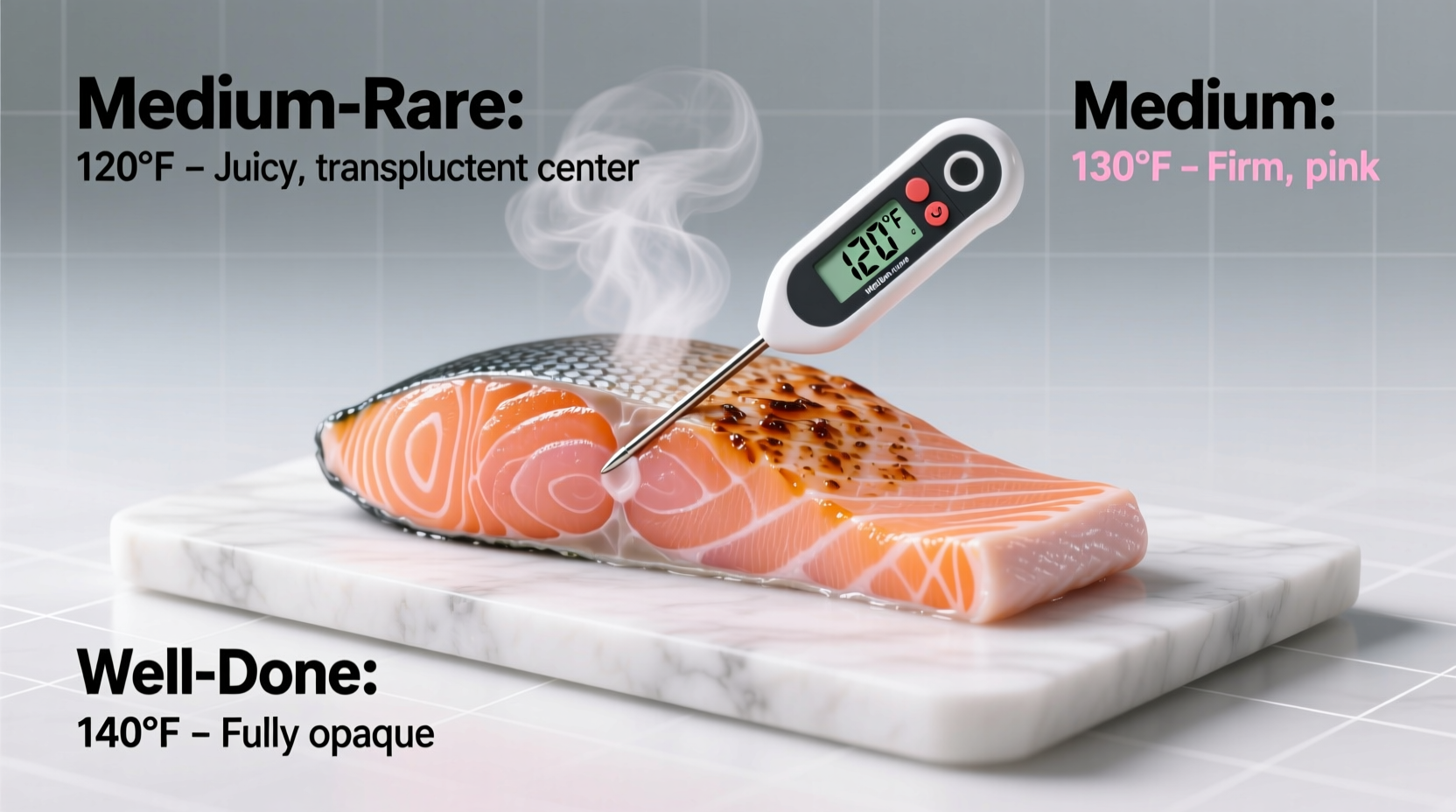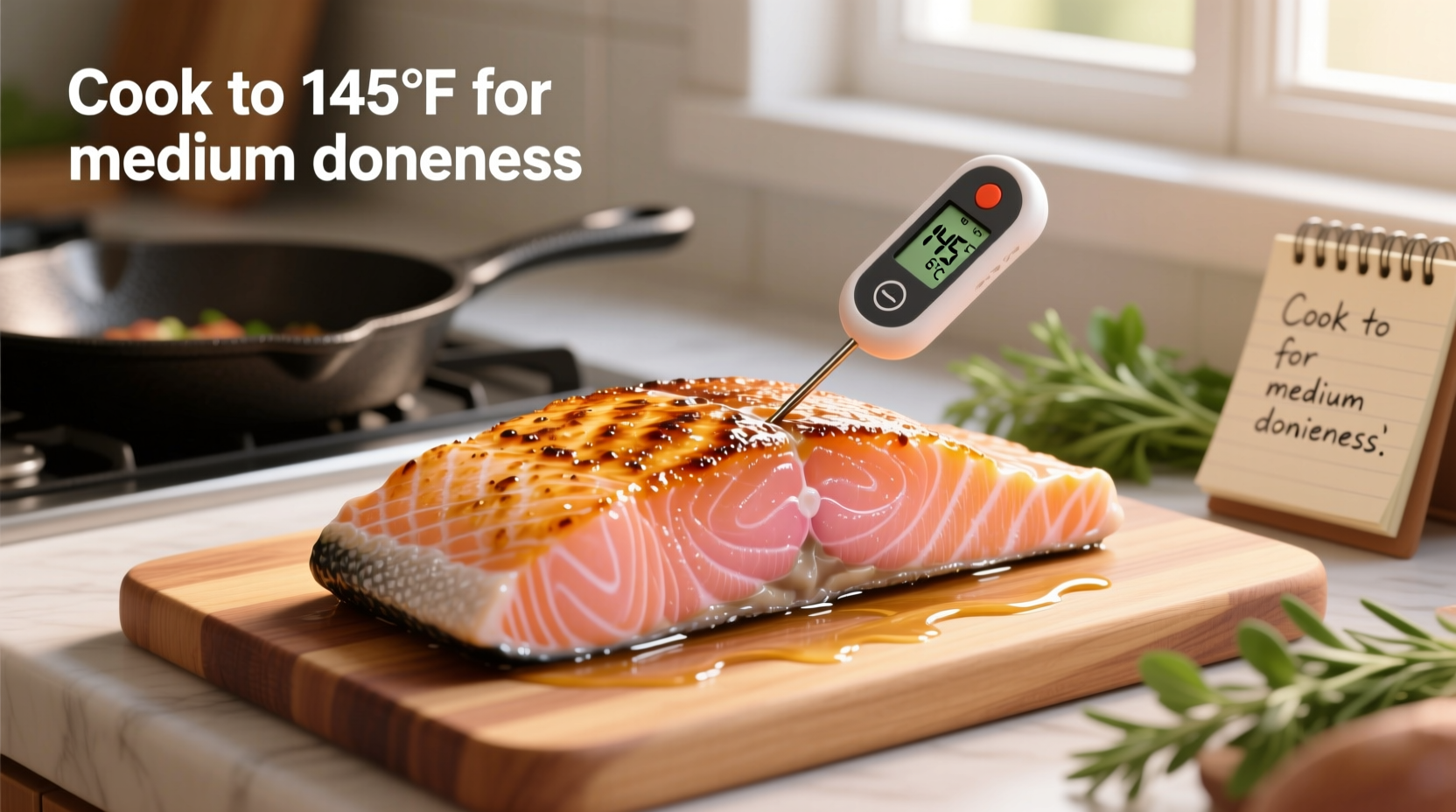Why Temperature Matters More Than Time for Perfect Salmon
Unlike many proteins where timing alone can suffice, salmon requires precise temperature control. This delicate fish transitions from perfectly moist to dry and flaky within a narrow 5-10 degree window. Understanding the science behind salmon's temperature transformation ensures consistent results whether you're baking, pan-searing, or grilling.
The Science Behind Salmon's Perfect Doneness
Salmon's protein structure begins to denature at 110°F (43°C), with the optimal texture achieved between 125-135°F (52-57°C). At these temperatures, the fish remains moist with a slight translucence in the center while still being safe to eat. The USDA's 145°F recommendation ensures destruction of all potential pathogens but often sacrifices quality for absolute safety.
| Doneness Level | Internal Temperature | Visual Characteristics | Texture |
|---|---|---|---|
| Medium-Rare | 120-125°F (49-52°C) | Translucent center, slight resistance when pressed | Buttery, moist, slightly firm |
| Medium | 130-135°F (54-57°C) | Opaque with slight translucence in center | Firm but still moist, flakes easily |
| Well-Done | 140-145°F (60-63°C) | Completely opaque, no translucence | Dry, crumbly, easily overcooked |
How to Measure Salmon Temperature Correctly
Using an instant-read thermometer is the only reliable method for determining salmon's doneness. Insert the probe into the thickest part of the fillet, avoiding the bone if present. For accuracy:
- Calibrate your thermometer regularly using ice water (32°F/0°C) or boiling water (212°F/100°C)
- Wait 3-5 seconds for the reading to stabilize
- Check multiple spots in larger fillets
- Remove salmon from heat when 5 degrees below your target temperature

Cooking Method Variations and Temperature Adjustments
Different cooking methods require slight temperature adjustments due to varying heat transfer rates:
Oven-Roasted Salmon
Preheat oven to 375-400°F (190-204°C). Roast until internal temperature reaches 125°F (52°C), typically 10-12 minutes for a 6-ounce fillet. The gentle, even heat of an oven requires less temperature adjustment for carryover cooking.
Pan-Seared Salmon
Heat oil in a skillet over medium-high heat. Sear skin-side down first for 6-8 minutes, then flip and cook 2-4 minutes more. Remove at 120°F (49°C) as the residual heat in the pan creates significant carryover cooking. The USDA Food Safety and Inspection Service confirms that proper searing creates a protective barrier that minimizes surface bacteria concerns even at lower internal temperatures (fsis.usda.gov).
Grilled Salmon
Preheat grill to medium-high (375-400°F). Grill skin-side down for 6-8 minutes, then flip for 2-4 minutes. Remove at 122°F (50°C) as the intense radiant heat causes faster temperature rise. The American Heart Association recommends grilling as a heart-healthy cooking method that preserves omega-3 fatty acids better than high-heat frying (heart.org).
Visual Cues When You Don't Have a Thermometer
While a thermometer is essential for precision, these visual indicators can help when one isn't available:
- Flakiness test: Gently press the thickest part with a fork - it should flake slightly but remain cohesive
- Color change: Translucent pink should become opaque salmon color from outside toward center
- Resistance: Properly cooked salmon offers slight resistance when pressed, then springs back
Avoiding Common Temperature Mistakes
Many home cooks make these critical temperature errors:
- Over-relying on timing: Fillet thickness varies significantly - temperature is the only reliable indicator
- Not accounting for carryover cooking: Salmon continues cooking 5-10 degrees after removal from heat
- Checking too early: Opening the oven or moving fish too soon disrupts cooking
- Ignoring resting time: Always let salmon rest 5 minutes before serving to allow temperature equalization
Food Safety Considerations for Lower Temperature Cooking
Cooking salmon below the USDA's 145°F recommendation is safe when proper handling protocols are followed. According to research published in the Journal of Food Protection, salmon cooked to 125°F for 30 seconds achieves equivalent pathogen reduction to 145°F when the fish has been properly handled and stored (jfoodprotection.org). Key safety practices include:
- Using fresh, high-quality salmon from reputable sources
- Keeping fish refrigerated below 40°F until ready to cook
- Cooking immediately after removing from refrigerator
- Consuming within 2 hours of cooking
Perfecting Your Salmon Cooking Process
For consistently perfect results, follow this temperature-focused process:
- Bring salmon to room temperature for 15-20 minutes before cooking
- Preheat your cooking surface to the proper temperature
- Season and place salmon on cooking surface
- Monitor temperature closely during the final 2-3 minutes of cooking
- Remove at 120-125°F for medium-rare or 130°F for medium
- Rest for 5 minutes before serving
Troubleshooting Temperature Issues
Encountering problems? These temperature-related fixes can help:
- Dry, overcooked salmon: You're likely cooking to 145°F or not accounting for carryover cooking
- Too translucent center: Fish may be slightly under 125°F - return to gentle heat for 1-2 minutes
- Inconsistent doneness: Check multiple spots as thicker areas need more time
- Sticking to pan: Surface isn't hot enough before adding fish - proper searing creates a release barrier
Conclusion: Finding Your Perfect Salmon Temperature
The "perfect" salmon temperature ultimately depends on your personal preference and risk tolerance. For most home cooks, 130-135°F delivers the ideal balance of safety and quality. By understanding the science behind temperature changes and using a reliable thermometer, you'll consistently achieve restaurant-quality results that showcase salmon's delicate flavor and texture.











 浙公网安备
33010002000092号
浙公网安备
33010002000092号 浙B2-20120091-4
浙B2-20120091-4